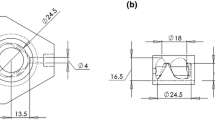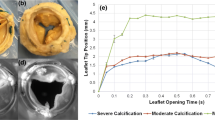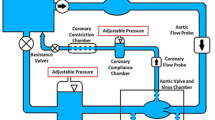Abstract
The aortic sinus vortex is a classical flow structure of significant importance to aortic valve dynamics and the initiation and progression of calcific aortic valve disease. We characterize the spatiotemporal characteristics of aortic sinus vortex dynamics in relation to the viscosity of blood analog solution as well as heart rate. High-resolution time-resolved (2 kHz) particle image velocimetry was conducted to capture 2D particle streak videos and 2D instantaneous velocity and streamlines along the sinus midplane using a physiological but rigid aorta model fitted with a porcine bioprosthetic heart valve. Blood analog fluids used include a water–glycerin mixture and saline to elucidate the sensitivity of vortex dynamics to viscosity. Experiments were conducted to record 10 heart beats for each combination of blood analog and heart rate condition. Results show that the topological characteristics of the velocity field vary in timescales as revealed using time bin-averaged vectors and corresponding instantaneous streamlines. There exist small timescale vortices and a large timescale main vortex. A key flow structure observed is the counter vortex at the upstream end of the sinus adjacent to the base (lower half) of the leaflet. The spatiotemporal complexity of vortex dynamics is shown to be profoundly influenced by strong leaflet flutter during systole with a peak frequency of 200 Hz and peak amplitude of 4 mm observed in the saline case. While fluid viscosity influences the length and timescales as well as the introduction of leaflet flutter, heart rate influences the formation of counter vortex at the upstream end of the sinus. Higher heart rates are shown to reduce the strength of the counter vortex that can greatly influence the directionality and strength of shear stresses along the base of the leaflet. This study demonstrates the impact of heart rate and blood analog viscosity on aortic sinus hemodynamics.











Similar content being viewed by others
References
Balachandran K et al (2010) Elevated cyclic stretch induces aortic valve calcification in a bone morphogenic protein-dependent manner. Am J Pathol 177(1):49–57
Beelen MJ, Neerincx PE, van de Molengraft MJG (2011) Control of an air pressure actuated disposable bioreactor for cultivating heart valves. Mechatronics 21(8):1288–1297
Bellofiore A, Donohue EM, Quinlan NJ (2011) Scale-up of an unsteady flow field for enhanced spatial and temporal resolution of PIV measurements: application to leaflet wake flow in a mechanical heart valve. Exp Fluids 51(1):161–176
Chrisohoides A, Sotiropoulos F (2003) Experimental visualization of Lagrangian coherent structures in aperiodic flows. Phys Fluids 15(3):L25–L28
Dumont K et al (2002) Design of a new pulsatile bioreactor for tissue engineered aortic heart valve formation. Artif Organs 26(8):710–714
Falahatpisheh A, Kheradvar A (2012) High-speed particle image velocimetry to assess cardiac fluid dynamics in vitro: from performance to validation. Eur J Mech B Fluids 35:2–8
Fisher CI, Chen J, Merryman WD (2013) Calcific nodule morphogenesis by heart valve interstitial cells is strain dependent. Biomech Model Mechanobiol 12(1):5–17
Freeman RV, Otto CM (2005) Spectrum of calcific aortic valve disease—pathogenesis, disease progression, and treatment strategies. Circulation 111(24):3316–3326
Hjortnaes J, New SEP, Aikawa E (2013) Visualizing novel concepts of cardiovascular calcification. Trends Cardiovasc Med 23(3):71–79
Kaminsky R et al (2007) Flow visualization through two types of aortic prosthetic heart valves using stereoscopic high-speed particle image velocimetry. Artif Organs 31(12):869–879
Kilner PJ et al (1993) Helical and retrograde secondary flow patterns in the aortic-arch studied by 3-directional magnetic-resonance velocity mapping. Circulation 88(5):2235–2247
Kvitting JPE et al (2004) Flow patterns in the aortic root and the aorta studied with time-resolved, 3-dimensional, phase-contrast magnetic resonance imaging: implications for aortic valve-sparing surgery. J Thorac Cardiovasc Surg 127(6):1602–1607
Leo HL et al (2006) Fluid dynamic assessment of three polymeric heart valves using particle image velocimetry. Ann Biomed Eng 34(6):936–952
Markl M et al (2012) 4D flow MRI. J Magn Reson Imaging 36(5):1015–1036
Miller JD, Weiss RM, Heistad DD (2011) Calcific aortic valve stenosis: methods, models, and mechanisms. Circ Res 108(11):1392–1412
Peacock JA (1990) An invitro study of the onset of turbulence in the sinus of valsalva. Circ Res 67(2):448–460
Querzoli G, Fortini S, Cenedese A (2010) Effect of the prosthetic mitral valve on vortex dynamics and turbulence of the left ventricular flow. Phys Fluids 22(4):041901
Ruiz P et al (2013) In vitro cardiovascular system emulator (bioreactor) for the simulation of normal and diseased conditions with and without mechanical circulatory support. Artif Organs 37(6):549–560
Saikrishnan N et al (2012) In vitro characterization of bicuspid aortic valve hemodynamics using particle image velocimetry. Ann Biomed Eng 40(8):1760–1775
Strecker C et al (2012) Flow-sensitive 4D MRI of the thoracic aorta: comparison of image quality, quantitative flow, and wall parameters at 1.5 T and 3 T. J Magn Reson Imaging 36(5):1097–1103
Sucosky P et al (2009) Altered shear stress stimulates upregulation of endothelial VCAM-1 and ICAM-1 in a BMP-4-and TGF-beta 1-dependent pathway. Arterioscler Thromb Vasc Biol 29(2):254–260
Sun L, Rajamannan NM, Sucosky P (2011) Design and validation of a novel bioreactor to subject aortic valve leaflets to side-specific shear stress. Ann Biomed Eng 39(8):2174–2185
Sun L, Chandra S, Sucosky P (2012) Ex vivo evidence for the contribution of hemodynamic shear stress abnormalities to the early pathogenesis of calcific bicuspid aortic valve disease. Plos One 7(10):e48843
Toger J et al (2012) Vortex ring formation in the left ventricle of the heart: analysis by 4D flow MRI and Lagrangian coherent structures. Ann Biomed Eng 40(12):2652–2662
Weiler M et al (2011) Regional analysis of dynamic deformation characteristics of native aortic valve leaflets. J Biomech 44(8):1459–1465
Weinberg EJ et al (2010) Hemodynamic environments from opposing sides of human aortic valve leaflets evoke distinct endothelial phenotypes in vitro. Cardiovasc Eng 10(1):5–11
Yap CH, Dasi LP, Yoganathan AP (2010a) Dynamic hemodynamic energy loss in normal and stenosed aortic valves. J Biomech Eng-Trans Asme 132(2):021005
Yap CH et al (2010b) Dynamic deformation characteristics of porcine aortic valve leaflet under normal and hypertensive conditions. Am J Physiol Heart Circ Physiol 298(2):H395–H405
Yap CH et al (2012) Experimental measurement of dynamic fluid shear stress on the aortic surface of the aortic valve leaflet. Biomech Model Mechanobiol 11(1–2):171–182
Yip CYY, Simmons CA (2011) The aortic valve microenvironment and its role in calcific aortic valve disease. Cardiovasc Pathol 20(3):177–182
Acknowledgments
The authors gratefully acknowledge funding from National Institutes of Health (NIH) under Award Number R01HL119824, and the American Heart Association under award 11SDG5170011. The content is solely the responsibility of the authors and does not necessarily represent the official views of the NIH. The authors also wish to acknowledge Steve Johnson for his machining help throughout this study.
Author information
Authors and Affiliations
Corresponding author
Electronic supplementary material
Below is the link to the electronic supplementary material.
Supplementary material 1 (MP4 13456 kb)
Supplementary material 2 (MP4 8522 kb)
Supplementary material 3 (MP4 23949 kb)
Supplementary material 4 (MP4 16521 kb)
Supplementary material 5 (MP4 3539 kb)
Supplementary material 6 (MP4 5182 kb)
Supplementary material 7 (MP4 6919 kb)
Rights and permissions
About this article
Cite this article
Moore, B., Dasi, L.P. Spatiotemporal complexity of the aortic sinus vortex. Exp Fluids 55, 1770 (2014). https://doi.org/10.1007/s00348-014-1770-0
Received:
Revised:
Accepted:
Published:
DOI: https://doi.org/10.1007/s00348-014-1770-0




